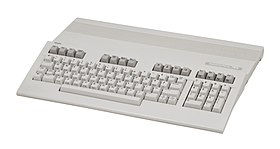Commodore 128
 |
|
| Type | Home computer |
|---|---|
| Release date | January 1985 |
| Discontinued | 1989 |
| Units sold | 5.7 million worldwide |
| Operating system | Commodore BASIC 7.0 Digital Research CP/M 3.0 |
| CPU | MOS 8502 @ 2 MHz Zilog Z80A @ 4 MHz |
| Memory | 128 kB |
| Graphics | VIC-II E (320×200, 16 colors, sprites, raster interrupt), MOS 8563 (RGBI 640×200 16 colors, blitter) |
| Sound | SID 6581/8580 (3× Osc, 4× Wave, Filter, ADSR, Ring) |
| Predecessor | Commodore 64 |
The Commodore 128, also known as the C128, C-128, C= 128, or occasionally CBM 128, is the last 8-bit home computer that was commercially released by Commodore Business Machines (CBM). Introduced in January 1985 at the CES in Las Vegas, it appeared three years after its predecessor, the bestselling Commodore 64.
The C128 is a significantly expanded successor to the C64, with nearly full compatibility. The newer machine has 128 kB of RAM in two 64 kB banks, and an 80-column color video output. It has a redesigned case and keyboard. Also included is a Zilog Z80 CPU which allows the C128 to run CP/M, as an alternative to the usual Commodore BASIC environment. The presence of the Z80 and the huge CP/M software library it brings, coupled with the C64's software library, gives the C128 one of the broadest ranges of available software among its competitors.
The primary hardware designer of the C128 was Bil Herd, who had worked on the Plus/4. Other hardware engineers were Dave Haynie and Frank Palaia, while the IC design work was done by Dave DiOrio. The main Commodore system software was developed by Fred Bowen and Terry Ryan, while the CP/M subsystem was developed by Von Ertwine.
The C128's keyboard includes four cursor keys, an Alt key, Help key, Esc key, Tab key and a numeric keypad. None of these were present on the C64. Previous Commodores had only two cursor keys, which required using the Shift key to move the cursor up or left. This alternate arrangement was retained on the 128, for use under C64 mode. The lack of a numeric keypad, Alt key, and Esc key on the C64 was an issue with some CP/M productivity software when used with the C64's Z80 cartridge. A keypad was requested by many C64 owners who spent long hours entering machine language programs using MLX. Many of the added keys matched counterparts present on the IBM PC's keyboard and made the new computer more attractive to business software developers. While the 128's 40-column mode closely duplicates that of the C64, an extra 1K of color RAM is made available to the programmer, as it is multiplexed through memory address 1. The C128's power supply is improved over the C64's unreliable design, being much larger and equipped with cooling vents and a replaceable fuse. The C128 does not perform a system RAM test on power-up like previous Commodore machines. Instead of the single 6510 microprocessor of the C64, the C128 incorporates a two-CPU design. The primary CPU, the 8502, is a slightly improved version of the 6510, capable of being clocked at 2 MHz. The second CPU is a Zilog Z80 which is used to run CP/M software, as well as to initiate operating-mode selection at boot time. The two processors cannot run concurrently, thus the C128 is not a multiprocessing system.
...
Wikipedia
